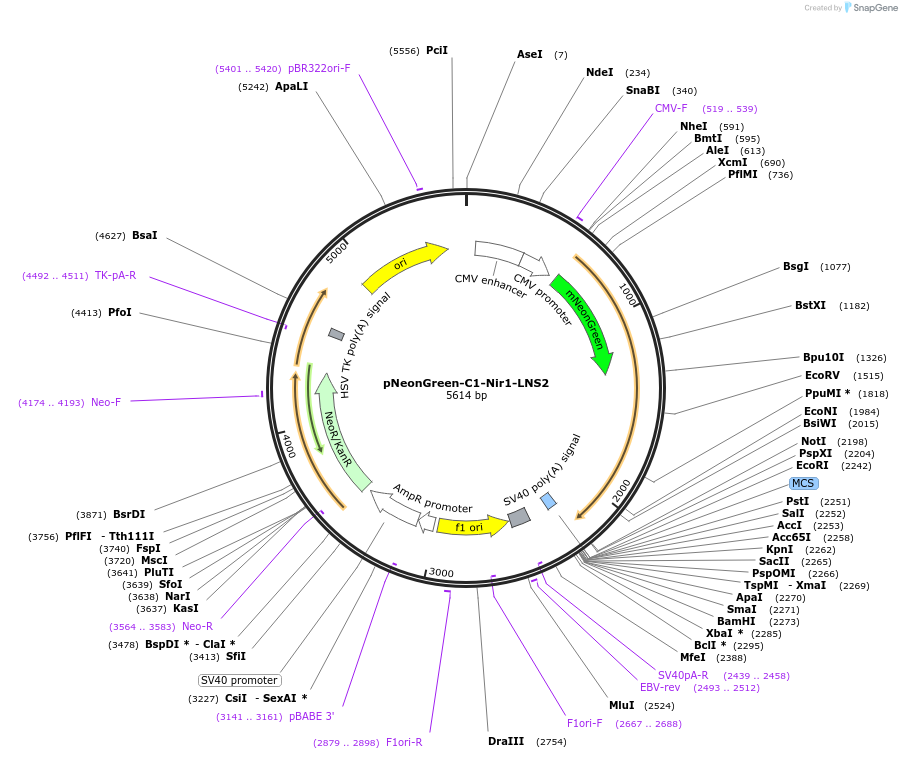pNeonGreen-C1-Nir1-LNS2
(Plasmid
#220083)
-
PurposeHigh affinity PA biosensor with green fluorophore (also known as NeonGreen-PILS-Nir1)
-
Depositing Lab
-
Sequence Information
Ordering
| Item | Catalog # | Description | Quantity | Price (USD) | |
|---|---|---|---|---|---|
| Plasmid | 220083 | Standard format: Plasmid sent in bacteria as agar stab | 1 | $89 | |
Backbone
-
Vector backbonepNeonGreen-C1
-
Vector typeMammalian Expression
-
Selectable markersNeomycin (select with G418)
Growth in Bacteria
-
Bacterial Resistance(s)Kanamycin, 50 μg/mL
-
Growth Temperature37°C
-
Growth Strain(s)DH5alpha
-
Copy numberHigh Copy
Gene/Insert
-
Gene/Insert namePITPNM3
-
Alt nameNir1
-
SpeciesH. sapiens (human)
-
Insert Size (bp)855
-
Mutationamino acids 613-897
-
Entrez GenePITPNM3 (a.k.a. ACKR6, CORD5, NIR1, RDGBA3)
- Promoter CMV
-
Tag
/ Fusion Protein
- NeonGreen-GGSGGM (N terminal on insert)
Cloning Information
- Cloning method Gibson Cloning
Resource Information
-
Supplemental Documents
Terms and Licenses
-
Academic/Nonprofit Terms
-
Industry Terms
- Not Available to Industry
Trademarks:
- Zeocin® is an InvivoGen trademark.
Depositor Comments
The Nir1 sequence corresponds to a rare human allele (17-6455609-G-A (GRCh38) in the gnomAD database) with an A885V missense mutation relative to the reference genome. There is no known phenotype associated with mutation of this residue, and it is not predicted to disrupt membrane interactions. The residue is also not conserved between Nir orthologues.
This plasmid is named 'NeonGreen-PILS-Nir1' in Weckerly et al., 2025.
These plasmids were created by your colleagues. Please acknowledge the Principal Investigator, cite the article in which the plasmids were described, and include Addgene in the Materials and Methods of your future publications.
-
For your Materials & Methods section:
pNeonGreen-C1-Nir1-LNS2 was a gift from Gerry Hammond (Addgene plasmid # 220083 ; http://n2t.net/addgene:220083 ; RRID:Addgene_220083) -
For your References section:
PILS-Nir1 is a sensitive phosphatidic acid biosensor that reveals mechanisms of lipid production. Weckerly CC, Rahn TA, Ehrlich M, Wills RC, Pemberton JG, Airola MV, Hammond GRV. J Cell Biol. 2025 Nov 3;224(11):e202405174. doi: 10.1083/jcb.202405174. Epub 2025 Sep 9. 10.1083/jcb.202405174 PubMed 40923975



